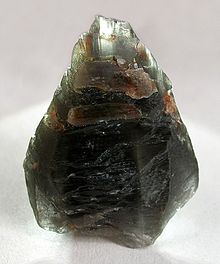
Back Сіліманіт BE Sil·limanita Catalan Sillimanit Czech Силлиманит CV Sillimanit German Sillimanita Spanish Sillimanita EU سیلیمانیت FA Sillimanite French סילימניט HE
| Sillimanite | |
|---|---|
 | |
| General | |
| Category | Nesosilicate |
| Formula (repeating unit) | Al2SiO5 |
| IMA symbol | Sil[1] |
| Strunz classification | 9.AF.05 |
| Dana classification | 52.02.02a.01 |
| Crystal system | Orthorhombic |
| Crystal class | Dipyramidal (mmm) H-M symbol: (2/m 2/m 2/m) |
| Space group | Pbnm |
| Unit cell | a = 7.47 Å, b = 7.66 Å c = 5.75 Å; Z = 4 |
| Identification | |
| Color | Colourless or white to grey, also brown, yellow, yellow-green, grey-green, blue-green, blue; colourless in thin section |
| Crystal habit | Prismatic crystals, fibrous, acicular |
| Cleavage | {010} perfect |
| Fracture | Splintery |
| Tenacity | Tough |
| Mohs scale hardness | 7 |
| Luster | Vitreous to subadamantine, silky |
| Streak | White |
| Diaphaneity | Transparent to translucent |
| Specific gravity | 3.24 |
| Optical properties | Biaxial (+) |
| Refractive index | nα = 1.653 – 1.661 nβ = 1.654 – 1.670 nγ = 1.669 – 1.684 |
| Birefringence | δ = 0.020 – 0.022 |
| Pleochroism | Colourless to pale brown to yellow |
| 2V angle | 21–30° |
| References | [2][3][4][5] |
Sillimanite or fibrolite is an aluminosilicate mineral with the chemical formula Al2SiO5. Sillimanite is named after the American chemist Benjamin Silliman (1779–1864). It was first described in 1824 for an occurrence in Chester, Connecticut.[4]
- ^ Warr, L.N. (2021). "IMA–CNMNC approved mineral symbols". Mineralogical Magazine. 85 (3): 291–320. Bibcode:2021MinM...85..291W. doi:10.1180/mgm.2021.43. S2CID 235729616.
- ^ "WebMineral entry". Retrieved 2009-12-19.
- ^ http://rruff.geo.arizona.edu/doclib/hom/sillimanite.pdf Handbook of Mineralogy
- ^ a b http://www.mindat.org/min-3662.html Mindat.org
- ^ MacKenzie, W. S.; Guilford, C. (1980). Atlas of rock-forming minerals in thin section. Essex: Longman Scientific & Technical. p. 10. ISBN 0-582-45591-X.
- ^ Whitney, D.L. (2002). "Coexisting andalusite, kyanite, and sillimanite: Sequential formation of three Al2SiO5 polymorphs during progressive metamorphism near the triple point, Sivrihisar, Turkey". American Mineralogist. 87 (4): 405–416. doi:10.2138/am-2002-0404.
